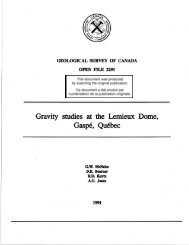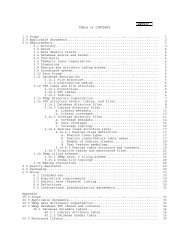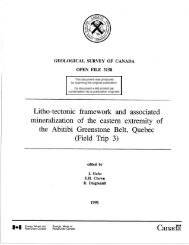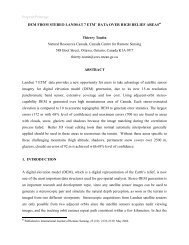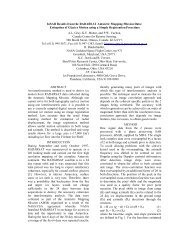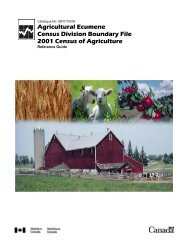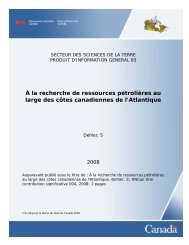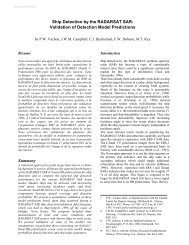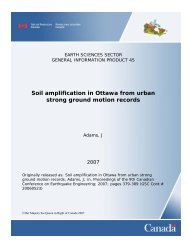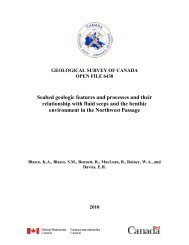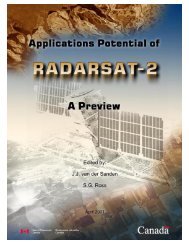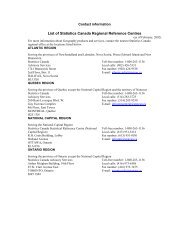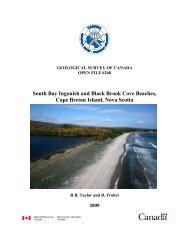GeoTour Guide for Terrace, British Columbia - GeoGratis - Natural ...
GeoTour Guide for Terrace, British Columbia - GeoGratis - Natural ...
GeoTour Guide for Terrace, British Columbia - GeoGratis - Natural ...
You also want an ePaper? Increase the reach of your titles
YUMPU automatically turns print PDFs into web optimized ePapers that Google loves.
GEOLOGICAL SURVEY OF CANADA<br />
OPEN FILE 5558<br />
<strong>GeoTour</strong> guide <strong>for</strong> <strong>Terrace</strong>, <strong>British</strong> <strong>Columbia</strong><br />
R.J.W. Turner, J. Nelson, R. Franklin, G. Weary, T. Walker,<br />
and C. McRae<br />
<strong>Natural</strong> Resources<br />
Canada<br />
Ressources naturelles<br />
Canada<br />
2010<br />
1
GEOLOGICAL SURVEY OF CANADA<br />
OPEN FILE 5558<br />
<strong>GeoTour</strong> <strong>Guide</strong> <strong>for</strong> <strong>Terrace</strong>, <strong>British</strong> <strong>Columbia</strong><br />
R.J.W. Turner, J. Nelson, R. Franklin, G. Weary, T. Walker,<br />
and C. McRae<br />
2010<br />
©Her Majesty the Queen in Right of Canada 2010<br />
This publication is available from the Geological Survey of Canada Bookstore<br />
(http://gsc.nrcan.gc.ca/bookstore_e.php).<br />
It can also be downloaded free of charge from GeoPub<br />
(http://geopub.nrcan.gc.ca/).<br />
Turner, R.J.W., J. Nelson, R. Franklin, G. Weary, T. Walker, and C. McRae. 2010. <strong>GeoTour</strong> guide <strong>for</strong><br />
<strong>Terrace</strong>, <strong>British</strong> <strong>Columbia</strong>: Geological Survey of Canada, Open File 5558, 22 p.<br />
Open files are products that have not gone through the GSC <strong>for</strong>mal publication process.<br />
2
GEOTOUR GUIDE<br />
FOR<br />
TERRACE, BRITISH COLUMBIA<br />
OUR LAND. OUR COMMUNITY<br />
Figure 1. View from Birch Bench subdivision looking to the southwest across the eastern end of <strong>Terrace</strong>, the Skeena River, Ferry<br />
Island (left), and the Coast Mountains (back, right). The <strong>Terrace</strong> Airport sits on the flat bench on the left skyline.<br />
Geological Survey of Canada Open File Report 5558<br />
(<strong>British</strong> <strong>Columbia</strong> Geological Survey Geofile 2007-10)<br />
R.J.W.Turner, Geological Survey of Canada; J. Nelson, <strong>British</strong> <strong>Columbia</strong> Geological Survey;<br />
R. Franklin, G. Weary, T. Walker, B. Hayward, and C. McRae<br />
3
TERRACE – LIVING ON THE LAND<br />
We live within the great Coast Range where the big Skeena River flowing west to the Pacific crosses the wide northsouth<br />
Kitsumkalum-Kitimat Valley. This region is underlain by diverse geological materials and is continually shaped<br />
by earth processes. <strong>Terrace</strong>,<br />
like any other community, is<br />
dependent on the Earth <strong>for</strong><br />
water, food, materials, energy.<br />
Not only does the Earth<br />
provide resources, but it<br />
accepts our wastes. This<br />
<strong>GeoTour</strong> field guide explores<br />
how our community of <strong>Terrace</strong><br />
“lives off the land”. What<br />
earth materials underlie this<br />
landscape and how do they<br />
affect us? How has the local<br />
landscape shaped human use<br />
of our area? What local earth<br />
resources do we depend on?<br />
Where does our drinking water<br />
supply come from? Where<br />
does our sewage go? Where<br />
does our garbage go? Where<br />
does the energy that fuels our<br />
lives come from? Are we<br />
sustaining the land that<br />
sustains us?<br />
This guide tells its story of the<br />
geological landscape of<br />
<strong>Terrace</strong> by taking a tour. These<br />
<strong>GeoTour</strong> locations will be<br />
familiar to many, but this<br />
guide may inspire you to look<br />
with new “landscape eyes”.<br />
Figure 1a. Our community lives on and lives from the land. Our local lands provide essential resources such as water<br />
and sand and gravel <strong>for</strong> roads, asphalt, and concrete. Lands further away provide energy resources such as petroleum<br />
and natural gas, as well as metals and minerals. Our local lands also receive our wastes: garbage goes to landfills and<br />
waste water is treated and returned to the land.<br />
4
Figure 2. A schematic cut-away view of the <strong>Terrace</strong> area and underlying geological materials looking to the northeast. Circled<br />
numbers indicate the location of <strong>GeoTour</strong> sites discussed in guide.1. <strong>Terrace</strong> Mountain lookout. 2. Ferry Island Park river gravels.<br />
3. Old Bridge and Skeena River. 4.Old Remo Road limestone. 5. Kleanza Creek Provincial Park. 6. Heritage Park Museum mining<br />
displays. 7. Nass Valley lava flow. 8. Mount Layton hot springs. 9. Copper River landslide. 10. Sand and gravel quarry. 11.<br />
Concrete plant, Thornhill. 12. Frank Street municipal water well. 13. Municipal wastewater treatment plant. 14. Municipal<br />
landfill. 15. Rail terminal <strong>for</strong> petroleum products.<br />
HOW OUR LAND CAME TO BE.<br />
A QUICK TOUR THROUGH GEOLOGIC TIME<br />
So, how old is <strong>Terrace</strong>? Well, European settlement of the <strong>Terrace</strong> area goes back to the mid 1800s. On the other hand,<br />
First Nations settlement in the region is much older and goes back thousands of years. But the land itself is much,<br />
much, much older. What follows is a brief summary of the geological history that geologists have pieced together <strong>for</strong><br />
the <strong>Terrace</strong> area.<br />
(1) ANCIENT SEAFLOOR AND VOLCANOES<br />
The oldest rocks in the <strong>Terrace</strong> area are volcanic lava and limestone that <strong>for</strong>med 270 million years ago. Many<br />
mountains in the <strong>Terrace</strong> area are carved from these rocks. The volcanic rocks erupted from ancient volcanoes on<br />
oceanic islands similar to modern-day Japan or Aleutian Islands. Limestone reefs <strong>for</strong>med in shallow waters<br />
surrounding these islands (Site 4).<br />
(2) CRUNCH!<br />
These volcanic islands collided with the western edge of North America, starting 180 million years ago, as the Atlantic<br />
Ocean started to open, and North America moved westwards. This collision welded the lavas, limestone, and other<br />
rocks to North America, adding to its landmass and moving its coastline westwards from east of Prince George (near<br />
5
the present site of McBride and Mackenzie) to the present day <strong>Terrace</strong> area. The collision caused mountains to rise as<br />
the lava and limestone were de<strong>for</strong>med into folds and broken by faults.<br />
Figure 3. Geological history of the <strong>Terrace</strong> area is presented as a clock and shows how the geological materials at Geotour stops<br />
or sites fit into geological time. Note that equal divisions of the clock face represent highly unequal periods of time. Each<br />
geological material has a history of <strong>for</strong>mation. Geologists use fossils and radioactive elements contained in each geological<br />
material to determine its age. Much of this ancient history has been destroyed by erosion over geological time, leaving many gaps<br />
in our understanding.<br />
6
(3) SHALLOW SEAS, DINOSAURS, AND COAL<br />
Over time, the mountains eroded and a shallow sea spread eastwards to cover a large area from <strong>Terrace</strong> and Smithers<br />
to Dease Lake and Spatsizi Plateau Park. Rivers flowed into the sea from the east depositing thick deposits of sand,<br />
mud, and swamp peat. Dinosaurs roamed coastal swamps. Today, widespread sandstone and mudstone rocks contain<br />
coal deposits, natural gas, dinosaur footprints, and fossils.<br />
(4) CRUNCH AGAIN! AND GRANITES INTRUDE<br />
Another giant volcanic ocean island, referred to as “Wrangellia” by geologists, slammed into the western margin of<br />
North America, extending the continent westwards to the Queen Charlotte Islands. The collision folded and faulted the<br />
region and caused the Coast Mountains to rise. Along the coast, a subduction zone <strong>for</strong>med as Pacific Ocean crust slid<br />
below the Coast Mountains, causing deep rocks to melt. Some melted rock (magma) crystallized deep in the earth to<br />
<strong>for</strong>m great volumes of granitic rock (Site 1) that today make up much of the Coast Mountains.<br />
(5) THE LAND PULLS APART<br />
About 50 million years ago, much of <strong>British</strong> <strong>Columbia</strong> started to pull apart. The land broke into fault blocks, and the<br />
great Kitsumkalum-Kitimat valley <strong>for</strong>med (Site 1). Rocks under the valley subsided while the flanking mountains to<br />
the west and east rose along faults. These ancient faults remain today and act as conduits <strong>for</strong> hot waters that circulate<br />
deep below the valley, and rise to the surface at the Mt. Layton hot springs (Site 8).<br />
(6) THE ICE AGE<br />
Two million years ago, great continental ice sheets started to <strong>for</strong>m in northern North America. Ice Ages came and<br />
went. The last great Ice Age reached its maximum about 25,000 years ago when the ice sheet was two kilometers thick<br />
over the <strong>Terrace</strong> area and most parts of <strong>British</strong> <strong>Columbia</strong>. The slow-moving ice flowed from the BC Interior, where it<br />
was thickest, down the Skeena and Kalum-Kitimat valleys to the ocean, deepening the valleys. At the end of the Ice<br />
Age, the glacier front retreated northwards up the Kalum-Kitimat Valley. Several times the glacier retreat paused and<br />
thick plains of sand and gravel accumulated at the glacier snout (Site 10).<br />
(7) TODAY, THE RIVERS CARVE THEIR VALLEYS<br />
The modern Skeena River was born as the glaciers retreated, carrying waters from the central interior westward to the<br />
Pacific Ocean. The Skeena and Kitsumkalum rivers cut down through the thick glacial deposits that filled the valleys,<br />
<strong>for</strong>ming riverside cliffs that exposed the layers of glacial gravels and sands that today are important earth resources<br />
(Site 10) and aquifers (Site 12). As the rivers cut downwards, they also migrated back and <strong>for</strong>th, <strong>for</strong>ming river plains.<br />
Today the City of <strong>Terrace</strong> is built on a staircase of flat terraces or “benches” that mark <strong>for</strong>mer river plains, now<br />
abandoned above the present river plain. The city is named after these geological features. A good example of a <strong>for</strong>mer<br />
river plain surface, now left high and dry, is the “Horseshoe” area on the north side of <strong>Terrace</strong>. The cliffs around “the<br />
Horseshoe” were cut by the Skeena River at an earlier time.<br />
7
(SITE 1) TERRACE MOUNTAIN LOOKOUT:<br />
THE BIG VALLEY, A “FAULTY” HISTORY, AND GRANITE FOUNDATIONS<br />
Figure 4. View from <strong>Terrace</strong> Mountain looking west across the Kitsumkalum-Kitimat Valley to Sleeping Beauty Mountain and<br />
Coast Mountains. <strong>Terrace</strong> is in the <strong>for</strong>eground. Curiously, the Skeena River flows across, rather than down, the valley. Photo by<br />
Bonnie Hayward.<br />
TAKE A LOOK AT THE VIEW!<br />
So, with our geological history in mind, let’s head out and take a look at the landscapes of <strong>Terrace</strong>. The first site is the<br />
viewpoint on <strong>Terrace</strong> Mountain above the east side of town. From the viewpoint, a landscape unfolds to the west and<br />
southwest.<br />
Figure 5. The Big Valley – a faulty history. The Kitsumkalum Valley <strong>for</strong>med by movement on faults that caused the valley to<br />
subside relative to the adjacent mountains.<br />
<strong>Terrace</strong> lies within the northsouth<br />
Kitsumkalum-Kitimat<br />
Valley, bound to the west by<br />
the Coast Mountains and the<br />
east by the Hazelton<br />
Mountains. This is one of the<br />
largest coastal valleys in<br />
<strong>British</strong> <strong>Columbia</strong>. The Skeena<br />
River flows in its own smaller<br />
valley from east to west,<br />
crossing the larger north-south<br />
valley. Geologists find this<br />
curious – the Kitsumkalum and<br />
Kitimat Rivers seem too small<br />
to have carved the big valley. It<br />
is likely that at some time in<br />
the geological past, a much<br />
larger river flowed down the<br />
Kitsumkalum-Kitimat Valley,<br />
eroding<br />
its great width.<br />
8
HOW THICK WAS THE GLACIER DURING THE LAST ICE AGE?<br />
You can an answer to this question by observing the shape of the mountains. Most of the Coast Mountains to the west<br />
have rounded summits that indicate that glacier ice flowed over them. Only the very highest peaks are sharp and<br />
irregular, indicating they poked above the highest limits of the glacier. So as you look at the view, imagine the valleys<br />
filled with glacier ice and only the highest sharp peaks sticking through!<br />
TAKE A LOOK AT WHAT’S AT YOUR FEET!<br />
At the lookout, you are standing on a light grey coloured granitic rock. The rock<br />
has a salt-and-pepper texture reflecting the intergrowth of light (feldspar, quartz)<br />
and dark minerals (hornblende, black mica) that crystallized from a rock melt<br />
(magma). The Coast Mountains, from Vancouver to Alaska, have been referred to<br />
as “Granite Country” because of the tremendous abundance of granitic rock<br />
relative to other parts of <strong>British</strong> <strong>Columbia</strong>. Granitic rock usually contains<br />
fractures that tend to be widely spaced and there<strong>for</strong>e granite resists erosion. As a<br />
result, granite often <strong>for</strong>ms very stable, steep cliffs such as the western face of<br />
Copper Mountain, and is there<strong>for</strong>e a favourite of local climbers.<br />
Figure 6. Granitic rock with salt and pepper texture.<br />
Photo by Bonnie Hayward.<br />
GO TAKE A LOOK<br />
Drive east from downtown on Park St up to Birch Bench. Turn left on Johnstone<br />
Street. The trail head is on the right. The trail to the lookout rises about 200<br />
metres and takes about 45 minutes to an hour and a half to climb.<br />
(SITE 2) FERRY ISLAND PARK AND SKEENA RIVER GRAVEL BARS:<br />
DIVERSE ROCK TYPES, NICELY POLISHED<br />
Figure 7. Gravels exposed on the gravel bar at Ferry Island. Photo by Bob Turner.<br />
Ferry Island is just one of many islands in the Skeena River near<br />
<strong>Terrace</strong>. Upstream of <strong>Terrace</strong>, the Skeena River flows fast in a narrow<br />
valley. As the river enters the broad Kalum-Kitimat Valley, the river<br />
slows. Currents that have pushed gravel along the river bed from high<br />
in the mountains weaken, and the gravel accumulates, <strong>for</strong>ming<br />
mounds on the river bed that we call bars and islands. Ferry Island is<br />
an example of a large island that is old and stable enough to have an<br />
established <strong>for</strong>est. Islands fill the Skeena River all the way to the sea<br />
– this is the final dumping ground of the Skeena River as it meets the<br />
Pacific Ocean.<br />
Many different rock types underlie the <strong>Terrace</strong> region. If you drive to<br />
Hazelton, the dominant rock type is sandstone and shale.<br />
Kitsumkalum mountain is volcanic rock. If you drive west of <strong>Terrace</strong><br />
to the Coast Mountains, the dominant rocks are granite and gniess.<br />
Geologists compile maps of the distribution of different rock types<br />
and sediment types, or “geological maps”. These maps are very<br />
valuable in the search <strong>for</strong> mineral and energy resources such as<br />
copper, sand and gravel, oil and gas (see Figure 8).<br />
9
5<br />
Gravels offer a simple way to<br />
view the diversity of bedrock<br />
types. Gravels are fragments of<br />
rock that have been worn smooth<br />
by bumping, grinding, and sand<br />
blasting that take place in rivers<br />
over long periods of time. The<br />
smooth surfaces of pebbles,<br />
particularly if they are wetted,<br />
reveal detailed textures and<br />
colours that greatly assists in<br />
their identification. The diversity<br />
of pebble types reflects the<br />
extensive network of streams on<br />
all landscapes that scavenge<br />
materials eroded from rock,<br />
glacial gravels, and glacial tills,<br />
and concentrate them in stream<br />
beds.<br />
Figure 8. Map of rock types<br />
underlying the <strong>Terrace</strong> region (by<br />
Joanne Nelson).<br />
Figure 9. Different types of pebbles found on a bar<br />
in the Skeena River. Clockwise from lower left<br />
corner: 1) Brick red to purple volcanic lavas; 2)<br />
grey green lava with white rectangular feldspar<br />
crystals; 3) green lava (metamorphosed); 4) grey<br />
layered sandstone and mudstone; 5) white “salt and<br />
pepper” granitic rock. Photo by Bob Turner.<br />
River bars such as those around Ferry Island<br />
offer an excellent opportunity to inspect<br />
gravels, at least when the river levels are low<br />
(not during spring runoff and during heavy<br />
autumn rains!). Try to give each rock type a<br />
name based your observations of its colour,<br />
lustre, or texture. For example, you might<br />
decide you would call one the “grey dull swiss<br />
cheese rock” because it is full of holes, another<br />
“white, shiny, harder than knife rock”, and<br />
another “grey and black speckled “salt and<br />
pepper” rock”. Good luck!<br />
10
Here is what a geologist might call those same rocks.<br />
• Grey dull swiss cheese rock = volcanic lava<br />
• Brick red and purple rock, with some holes = volcanic lava)<br />
• Light grey and dark grey layered rock = sandstone (light grey) and mudstone (dark grey)<br />
• white, shiny, harder than knife = quartz from quartz veins<br />
• Grey green to pistachio green rock = metamorphosed volcanic rock<br />
• Purple-brown or red-brown shiny speckled rock = volcanic lava<br />
• Grey and black speckled “salt and pepper” rock = granitic rock<br />
• Layered grey and black speckled “salt and pepper” rock and black rock = gniess<br />
GO TAKE A LOOK: FERRY ISLAND<br />
Drive east from <strong>Terrace</strong> on Highway 16 to Ferry Island. Turn south (right) into the parking lot at the access road to the<br />
Ferry Island Campground. Take the trail east from the parking lot, under the highway bridge, and down to the gravel<br />
bar. At low water, the bar is large. At high water in spring and early summer the bar may be completely submerged.<br />
(SITE 3) OLD BRIDGE AND SKEENA RIVER<br />
Figure 10. View of the Skeena River and Old Bridge from Lakelse Road park. Site 3 is at the south (left) end of the bridge at a small<br />
beach and rock point. Photo by Bob Turner.<br />
At the south end of the Old Bridge (Skeena Bridge) over the Skeena River is a fisherman’s access to a small beach and a<br />
rock point. The rock ridge of <strong>Terrace</strong> Mountain meets the Skeena River here an the Skeena River has only partly cut a<br />
channel through these hard granitic rocks. The footings of the Skeena Bridge take advantage of the low ridge of granitic<br />
rock that crosses the Skeena River. Most of the Skeena River flow is <strong>for</strong>ced through a narrow underwater canyon over<br />
20m deep below the main span of the bridge.<br />
Walk out on the rock point. During floods, this rock ridge is submerged by the Skeena River. Can you see evidence that<br />
the river has flowed over these rocks? Look <strong>for</strong> potholes that are drilled into the rock by pebbles driven by swirling river<br />
water.<br />
GO TAKE A LOOK<br />
Drive east from the downtown on Highway 16. Turn north (left) at Highway 37 and east (left) at Queensway just be<strong>for</strong>e<br />
Skeena Bridge. A gravel road leads down towards the river about 100 m west of the bridge.<br />
11
(SITE 4) TROPICAL TERRACE? TERRACE’S OLDEST RESIDENTS? LOCAL<br />
LIMESTONES TELL THE STORY<br />
Who are <strong>Terrace</strong>’s oldest residents? One might argue that some clams, sponges, and other small creatures that<br />
have left us their fossilized remains<br />
in limestones near <strong>Terrace</strong> deserve that title. Geologists will tell you that<br />
they are about 270 million years old! And that they lived below a tropical sea! Things sure have changed since<br />
then.<br />
LOOK<br />
Drive west on<br />
Queensway<br />
from Skeena<br />
Bridge to Old Remo<br />
Rd.<br />
Turn west (right) and<br />
drive xx km. Pull off the<br />
road near the horse sign.<br />
Look <strong>for</strong> a small trail on the north side of the road<br />
leading down the slope.<br />
A short walk through the<br />
<strong>for</strong>est brings you in sight<br />
of a cliff rising out of the<br />
<strong>for</strong>est. The rock rubble<br />
at the base of the cliff is a<br />
good place to look <strong>for</strong><br />
fossils, such as brachiopods,<br />
pieces of coral and crinoids,<br />
fusilinids (look like<br />
rice grains). If you are adventurous,<br />
climb the<br />
rubble<br />
to the layered rock<br />
in the cliff. More small<br />
fossil s there, but please, leave them so others can<br />
admire them<br />
too!<br />
Figure 12. 270 million year old fossil of a tropical clam in limestone.<br />
Figure 13: Cliff of limestone 270 million years old. Grey fossil-bearing limestone is<br />
interlayered<br />
with layers of hard white quartz-rich rock. Photo by Joanne Nelson.<br />
GO TAKE A<br />
(SITE 5) KLEANZA CREEK: THERE’S GOLD IN THEM THAR HILLS<br />
Figure 14. Kleanza Creek at the Provinical<br />
Park picnic site where the creek flows out of the<br />
canyon. Photo by Bob Turner.<br />
Kleanza Creek Provincial Park is situated<br />
15 km northeast of <strong>Terrace</strong> on Highway 16,<br />
next to the beginning of a logging main that<br />
continues on the north side of the creek.<br />
During the late 1800’s and early 1900's,<br />
placer gold was mined from the gravels of<br />
Kleanza Creek. "Kleanza" is a Gitxsan<br />
word <strong>for</strong> gold. Now the creek is highly<br />
valued<br />
as a salmon run, and <strong>for</strong>est growth<br />
and natural erosion have mostly hidden the<br />
evidence of the century-old workings.<br />
12
If you want to try out gold panning <strong>for</strong> yourself, go outside the park to the upper reaches of Kleanza Creek or try any of<br />
the other streams that flow into the Skeena. All you need is a pie tin or frying pan. Fill it about half full of wet sand and<br />
half full of water. Hold it under the surface of the stream; rock it to settle the heavy grains to the bottom and then wash<br />
the lighter grains off the top. Repeat until you have a little bit of dark-colored residue in the bottom. Swirl this around<br />
and<br />
look <strong>for</strong> shiny, pinprick-sized gold grains. Chances are you won't find any - the early prospectors were very thorough<br />
in their work - but you may be rewarded with a little train of black metallic grains (magnetite) or pink ones (garnet).<br />
(SITE 6) HERITAGE PARK MUSEUM: THE HARD LIFE OF EARLY MINERS<br />
Skeena River valley has been a well-travelled transportation corridor probably since the first peoples arrived. Until the<br />
late 1800's, getting there required a canoe and a team<br />
of strong, determined paddlers to negotiate the rapids, and riches<br />
were mainly trade goods running between the coast<br />
and the interior. The coming of sternwheelers in 1890, and the<br />
railroad in 1914, brought a new kind of explorer to the region:<br />
hardrock prospectors and miners. They plowed through thickets of<br />
devil's club and scrambled up the highest peaks in search of gold,<br />
silver, and copper. They threaded trails through precipices: one of<br />
these climbed in 64 dizzying switchbacks to a high pass at the head of<br />
Chimdemash Creek. The Bornite Mountain hiking trail north of<br />
Kleanza Creek once led to the Singlehurst property, one of the busiest<br />
mining operations in the <strong>Terrace</strong> area. Sixty-five men worked there in<br />
1900. They drove a shaft into the gold-bearing<br />
quartz vein by hand,<br />
constructed<br />
a headframe, and used a horse-powered winch (a<br />
"whim") to haul ore and rock waste out of the shaft.<br />
Figure 15 “Air in. Ore out” Life at the Singlehurst mine. A horse-powered<br />
winch (“whim”) lifts a bucket of ore from the shaft of the Singlehurst mine.<br />
Miners at the bottom of the shaft work in tunnels that follow the<br />
ore. They<br />
depend on their co-worker with a giant bellows on surface to pump fresh air<br />
into the<br />
mine down a long pipe. (Drawing by Joanne Nelson).<br />
GO TAKE A LOOK<br />
There's a miner's cabin at the Heritage Park Museum on Kalum Drive<br />
north of <strong>Terrace</strong> where you can see the whim and ore bucket from the<br />
Singlehurst mine. Go inside the cabin and check out the ore and fossil<br />
specimens and hand-<strong>for</strong>ged miners' tools. Pick up the hand steels and<br />
imagine drilling a hole into the rock, hammer<br />
blow by hammer blow,<br />
one chip at a time. Think: maybe this blast will be the good one, maybe reveal a glittering<br />
fracture face of free gold. Or<br />
maybe not. Or maybe next week you can pack back down the mountain <strong>for</strong> the winter, enjoy a<br />
little piano music or a dance <strong>for</strong> the bachelors<br />
hosted<br />
by one of the families at Usk … Across<br />
the lawn at the historic park, the Kalum<br />
Lake Hotel<br />
gives a glimpse at what civilized com<strong>for</strong>ts<br />
a weary miner could enjoy after a season<br />
working<br />
his claims. (Also<br />
w ww.heritageparkmuseum.com)<br />
Figures 16 and 17.<br />
The bucket (right) and whim<br />
or horse-powered winch (left) from the<br />
Singlehurst mine<br />
are on display at the Heritage Park Museum.<br />
Photos by Bob Turner.<br />
13
(SITE 7) NASS VALLEY LAVA FLOW: A NATURAL TRAGEDY<br />
Figure 18. Near Gitwinksilk, the lava surface is made up of lava rubble. The surface of the lava “froze” into a rock crust while<br />
underlying lava remained liquid and continued<br />
to flow, causing the crust to break into rubble.<br />
An hour north of <strong>Terrace</strong> up the Nisg'a' Highway is an amazing sight. The<br />
highway leaves the wet <strong>for</strong>ested landscapes typical of the Coast Range to enter<br />
an open expanse of bare rock and rock rubble that extends along the valley<br />
floor <strong>for</strong> more than 20 kilometres. This is a lava flow that erupted into the<br />
valley only 250 years ago. So recently that little grows on the lavas except <strong>for</strong><br />
moss and lichen. The lava flow destroyed several Nisga’a villages with great<br />
loss of life and temporarily blocked the Nass River. The lavas permanently<br />
blocked Tseax River, flooding the valley and <strong>for</strong>ming Lava Lake. It<br />
trans<strong>for</strong>med a lush <strong>for</strong>ested valley to a rocky desert landscape. The lava flowed<br />
from<br />
a fracture in the Earth near Tseax Cone,<br />
a 100 m high cone of volcanic<br />
cinders erupted during the lava eruption.<br />
Figure 19.<br />
Map of Nass River lava flow.<br />
Figure 20. A close up<br />
of dark lava filled with<br />
gas bubble casts. Gas<br />
was “fizzing” from the<br />
lava as it flowed, much<br />
like a soda drink. As the<br />
lava cooled, these<br />
bubbles were “frozen”<br />
into the rock and are<br />
still there today. Photos<br />
by Bob Turner.<br />
14
(SITE 8) MOUNT LAYTON HOT SPRINGS: WATER FROM DEEP<br />
IN THE EARTH<br />
The hot waters that flow to the surface at Mount Layton hot springs south of <strong>Terrace</strong> remind us that deep below us the<br />
Earth is very hot. These hothsprings are the hottest in Canada at 89 degrees Celsius, and have been developed into a<br />
resort and water park. So as you soak in the hot tub or pool, remember you are being warmed by the Earth, literally!<br />
Figure 21 and 22. (left) Swimming pool<br />
at hot springs. (right) Unused concrete<br />
pool built around one of the hot<br />
springs. Photos by Bob Turner.<br />
Mount Layton hot springs, also<br />
known as Lakelse hot springs,<br />
include at least half a dozen warm<br />
seeps that straddle Highway 37 and<br />
flow into wetlands that surround<br />
the resort area. Warm springs may<br />
also occur on the floor of Lakelse<br />
Lake, as soft spots are reported in<br />
the winter lake ice by locals.<br />
The Kalum-Kitimat valley <strong>for</strong>med millions of years ago by movement on faults that allowed rocks under the valley to<br />
sink, while adjacent rocks rose to <strong>for</strong>m the Coast and Hazelton Mountains. Geologists refer to the Kitsumkalum-Kitimat<br />
valley as a fault-bound valley. It is likely that the magma that erupted as the Nass Valley lava flow 250 years ago rose<br />
along these same faults.<br />
HOW DO FAULTS CREATE HOT<br />
SPRINGS?<br />
Faults are the pathways that allow hot<br />
waters to move quickly to the surface<br />
be<strong>for</strong>e supply the deep earth with water!<br />
Snowmelt and rainwater that fall on the<br />
mountains percolate down along faults.<br />
As the waters descend, the waters are<br />
warmed by the Earth, which increases in<br />
temperature with depth. Earth heat<br />
comes from heat generated by<br />
radioactive decay of elements such as<br />
uranium. Deep below the valley, down<br />
perhaps 6 or more kilometers, the waters<br />
reach temperatures of 100 degrees<br />
Celsius or more. Some of these hot (and<br />
lighter) waters rise on other faults,<br />
pushed to the surface by the weight of<br />
cool (and heavier) descending water. Hot<br />
waters cool somewhat as they rise,<br />
mixing with cool shallow groundwater,<br />
and reach the surface at temperatures<br />
near 89 degrees Celsius.<br />
Figure 23. Schematic view of the geothermal “plumbing system” that feeds the hot springs<br />
GO TAKE A LOOK<br />
The hot springs resort is about 30 kilometres south of <strong>Terrace</strong> along the Highway 37.<br />
15
(SITE 9) HIGHWAY 16 SAND AND GRAVEL PITS:<br />
VITAL RESOURCES FROM ANCIENT GLACIAL RIVERS<br />
<strong>Terrace</strong>, it is blessed with many nearby quarries to meet this need.<br />
Figure 24. A gravel pit in an Ice Age bench along<br />
Highway 16 just east of the Kitsumkalum River<br />
bridge. The cliff exposes thick sand and gravel<br />
deposits (grey) overlain by a 3-5m layer of clay<br />
and silt (tan). Photo by Bob Turner.<br />
The <strong>Terrace</strong> area has extensive deposits of<br />
sand and gravel. You might be surprised to<br />
learn how important these earth materials<br />
are to the community. Buried gravel and<br />
sand layers below <strong>Terrace</strong> “aquifers” contain<br />
groundwater that supplies the City of<br />
<strong>Terrace</strong> with its high quality drinking water<br />
(Site 12). Gravel and sand are also essential<br />
components of concrete and asphalt (Site<br />
11). Pause <strong>for</strong> a second to consider <strong>Terrace</strong><br />
without concrete (no large buildings,<br />
highway overpasses, sidewalks, roadside<br />
curbs, storm sewers!) or asphalt (no paved<br />
roads or parking lots!). Fortunately <strong>for</strong><br />
Figure 25. (below) A gravel pit along Highway 16 near the Kitsumkalum River. Sand and gravel deposits are sorted by<br />
screening into separate piles of gravel and sand, and each is sold <strong>for</strong> different purposes. Photo by Bob Turner.<br />
GO TAKE A LOOK<br />
Drive west from downtown along Highway 16. A large gravel pit operation is on the north side of the highway just<br />
be<strong>for</strong>e the bridge over the Kitsumkalum River.<br />
SO WHERE DID ALL THIS GRAVEL COME FROM?<br />
The answer: ancient rivers. Sand and gravel deposits <strong>for</strong>m the flat benches north of town and south of the river at the<br />
airport. These benches are flat because they <strong>for</strong>med as ancient river plains. The Skeena and Kitsumkalum rivers have cut<br />
down through these thick deposits, <strong>for</strong>ming their own gravel deposits as low terraces such as the “Horseshoe” area of<br />
north <strong>Terrace</strong>. The gravel banks, bars, and islands of the Skeena River, visible when river levels are low, remind us that<br />
rivers create sand and gravel deposits as they flush the finer materials such as silt and clay downstream, leaving behind<br />
clean gravels and sand.<br />
16
Figure 26. An interpreted history of the <strong>Terrace</strong> area at the end of the<br />
Ice Age illustrating the <strong>for</strong>mation of sand plains that today are the flat<br />
elevated benches (or terraces) that host the airport, the Heritage Park<br />
Museum and cemetery in northern <strong>Terrace</strong>, and Onion Lake south of<br />
Lakelse Lake.<br />
17
(SITE 10) MAKING CONCRETE AND ASPHALT:<br />
DIGGING OUR LOCAL GRAVEL AND SAND<br />
Try to imagine <strong>Terrace</strong> without concrete. No Highway 16 bridge. No multistory buildings downtown. No basements. No<br />
house foundations. No curbs. Now try to imagine <strong>Terrace</strong> without asphalt. No sealed or paved roads. No paved parking<br />
lots. Roads sure would be dusty in summer and muddy in winter. Hundreds of thousands of tons of concrete and asphalt<br />
are made and used each year in the <strong>Terrace</strong> area. It might<br />
surprise some to know that over 80% of all the asphalt and<br />
concrete used in the <strong>Terrace</strong> area is made of local sand and<br />
gravel.<br />
Figure 27. Concrete plant on Old Lakelse Lake Drive in<br />
Thornhill. The plant makes concrete aggregates, septic tanks,<br />
highway barriers, brick, block, paving stones, slabs, chimney<br />
blocks, and premixed sack products.<br />
Concrete is the most widely used construction material<br />
worldwide. Twice as much concrete is used in construction<br />
than all other building materials combined, including wood,<br />
steel, plastic and aluminum. Concrete is made by combining<br />
nine parts sand and gravel with one part cement. Sand and<br />
gravel make up the bulk of concrete; cement is the glue that<br />
holds it together. To make the cement “glue”, limestone, shale, and sand are mixed and ground to a fine powder, and<br />
then roasted at high heat. Cement necessary <strong>for</strong> <strong>Terrace</strong>’s concrete must be imported because the necessary limestone<br />
and shale are not available locally. <strong>Terrace</strong> has several plants that combine locally quarried sand and gravel with<br />
imported cement to make concrete.<br />
GO TAKE A LOOK<br />
Drive east from <strong>Terrace</strong> on Highway 16 across the Skeena River to Thornhill. Turn south on Old Lakelse Lake Drive. As<br />
the road climbs up the bench, note the abandoned and active quarries along the west side of the road. The Skeena<br />
Concrete Products Ltd plant is on the west side at the top of the bench.<br />
Figure 28. Asphalt plant<br />
on along Highway 16 east<br />
of Thornhill. Sand and<br />
gravel are quarried from<br />
Ice Age deposits, sorted,<br />
and combined with liquid<br />
asphalt at the plant.<br />
Asphalt is similar to<br />
concrete in that it is<br />
largely made up of local<br />
gravel and sand. It<br />
differs by using a<br />
different “glue”. Rather than using cement, it liquid asphalt, a tar-like substance that belongs to the hydrocarbon family<br />
that includes petroleum, natural gas, and gasoline. The liquid asphalt is brought to <strong>Terrace</strong> by rail car from a petroleum<br />
refinery in Lloydminster, Alberta. This plant processes heavy oil extracted from the Earth below Alberta.<br />
GO TAKE A LOOK: ASPHALT PLANT, HIGHWAY 16, EAST OF THORNHILL<br />
Drive east on Highway 16 from <strong>Terrace</strong> through Thornhill to the <strong>Terrace</strong> Paving access road on the south side. Call<br />
ahead if you would like to arrange a tour.<br />
18
(SITE 11) WHERE DOES OUR WATER COME FROM?<br />
THE RIVER? THE MOUNTAINS? TRY UNDER YOUR FEET!<br />
Water supply is a vital resource. The City of <strong>Terrace</strong> is supplied with water from a well within the town limits. The well<br />
is drilled into a deep sand and gravel deposit below <strong>Terrace</strong> that contains abundant groundwater.<br />
Figure 29. (left) City of <strong>Terrace</strong> wellhouse on Frank<br />
Street. Photo by Bob Turner.<br />
Figure 30. (below) A schematic cut-away view of the<br />
underground below <strong>Terrace</strong>. Sand and gravel bodies<br />
act as aquifers that contain the vital water supplies<br />
<strong>for</strong> <strong>Terrace</strong>.<br />
<strong>Terrace</strong>’s sand and gravel aquifer is about 15 metres thick and lies 40 metres below the surface. The spaces between the<br />
sand and gravel grains are full of very clean water. The sand and gravel provides natural filtration as the groundwater<br />
moves slowly through the aquifer. Separating this underground water supply from all the human activity in <strong>Terrace</strong> is a<br />
thick layer 20-30 metres thick of silt and clay. Water does not readily flow through these fine materials and this layer<br />
acts as a barrier against contaminants that might trickle downwards from the streets of <strong>Terrace</strong>. However, because the<br />
City is built on top of its water supply, it is possible that some spill someday could infiltrate down to the aquifer and<br />
contaminate it. Once contaminated, it would likely take many years to decades to “flush out” the aquifer. There<strong>for</strong>e, it is<br />
very important that industry, businesses, and homeowners use “best practices” to protect this water supply.<br />
Water use in <strong>Terrace</strong> averages 10,000 to 11,000 cubic metres per day, or 10 to 11 million litres per day. Water use<br />
doubles in the summer to over 20,000 cubic metres per day. To meet this demand, the City of <strong>Terrace</strong> uses additional<br />
water drawn from a reservoir on Deep Creek north of town. The source of water in Deep Creek is snowmelt and rainfall<br />
within the Deep Creek Watershed on the north side of <strong>Terrace</strong> Mountain.<br />
19
(SITE 12) WHERE DOES OUR WASTEWATER GO?<br />
AFTER TREATMENT, INTO THE SKEENA RIVER<br />
So, where does our sewage go when we drain the sink or flush the toilet? The answer <strong>for</strong> most parts of the town is the<br />
City of <strong>Terrace</strong> wastewater treatment plant on Graham Avenue near the Skeena River on the southwest side of town. The<br />
facility treats the waste water and discharges it into the Skeena River. The treated wastewater meets all requirements set<br />
by BC Environment.<br />
Wastewater treatment combines three major steps. Step 1: Solids, rags, sticks, plastics and other large objects greater<br />
than 25 mm are removed from the sewer flow using a screen. This debris is bagged and sent to the landfill. Step 2: After<br />
screening, the remaining sewer flow enters and flows through two aerated lagoons (see picture below) where bacteria<br />
breakdown of organic matter in the sewage. Air bubbled from a pipe system on the floor of the lagoon, and surface water<br />
sprays ensure the bacteria have sufficient oxygen to thrive. The wastewater circulates <strong>for</strong> about 3 weeks through two<br />
lagoons be<strong>for</strong>e it is ready <strong>for</strong> release into the river. Step 3 Once treated, the sewer flow is discharged into the Skeena<br />
River through an outfall pipe.<br />
Figure 31. A secondary treatment lagoon at the Graham Avenue wastewater treatment plant, City of <strong>Terrace</strong>. Small fountains within<br />
the lagoon mix and circulate oxygen into the wastewater. This oxygen is essential to bacteria that feed on and digest the organic<br />
matter, converting it to non-harmful products. Abundant green algae and plants on the surface reflect the nutrient-rich nature of the<br />
wastewater.<br />
GO TAKE A LOOK<br />
The City of <strong>Terrace</strong><br />
wastewater treatment plant<br />
is at the west end of<br />
Graham Avenue southwest<br />
of town. Tours of the plant<br />
are available if arranged in<br />
advance through the City<br />
of <strong>Terrace</strong>.<br />
(SITE 13) WHERE DOES OUR GARBAGE GO? TO A LANDFILL NEAR TOWN.<br />
How well do we manage our solid waste? How effectively do<br />
we reuse materials? Or recycle what we do not reuse? Dealing<br />
with garbage is a major task <strong>for</strong> local governments. Most<br />
garbage from the <strong>Terrace</strong> area goes to the municipal landfill<br />
about 4 km north of town on the Kalum Lake Road/Nisga’a<br />
Highway. There is also a landfill in Thornhill on Old Lakelse<br />
Lake Drive. Both landfills bury garbage within old sand and<br />
gravel quarries. A new landfill is currently under consideration<br />
by the Regional District of Kitimat-Stikine. The <strong>Terrace</strong> Bottle<br />
Depot on Kofoed Drive manages the recovery of beverage<br />
containers, residual paints, solvents, and other flammables. It<br />
also accepts corrugated cardboard, office paper, and plastic<br />
milk jugs.<br />
Figure 32. Garbage at Thornhill Landfill looking north toward Copper Mountain. The landfill is within an old sand and gravel<br />
quarry. Can you spot anything in this garbage pile that could have been recycled?<br />
GO TAKE A LOOK<br />
The Thornhill Landfill is located on Old Lakelse Lake Road, half way up the Airport Bench. Batteries, appliances, and<br />
automobiles are separated from mixed garbage.<br />
20
(SITE 14) NATURAL GAS. GASOLINE. DIESEL. HEATING OIL. AVIATION AND JET<br />
FUEL. PROPANE. WHERE DOES IT ALL COME FROM?<br />
Gasoline, other petroleum products, propane, and natural gas ducts are<br />
vital energy sources <strong>for</strong> transportation, industry, and homes. They reach<br />
<strong>Terrace</strong> in a variety of ways. <strong>Natural</strong> gas travels by pipeline from gas<br />
plants in northeastern BC. Gasoline, diesel fuels, heating oil, aviation and<br />
jet fuel are transported to <strong>Terrace</strong> by rail car and truck from refineries in<br />
Prince George and Edmonton. These are part of a broad range of<br />
products that along with asphalt and plastics are refined from oil and<br />
natural gas.<br />
Figure 33.<br />
<strong>Natural</strong> gas pipeline in Thornhill.<br />
Figure 29. Rail terminal <strong>for</strong> petroleum products,<br />
<strong>Terrace</strong>. Gasoline and diesel brought in by rail car is stored and transferred to<br />
tanker trucks <strong>for</strong> distribution to gas stations.<br />
Oil and natural gas come from the<br />
Earth. Most natural gas used in<br />
<strong>British</strong> <strong>Columbia</strong> comes from deep<br />
reservoirs below northeastern BC.<br />
Oil and natural gas are referred to as<br />
“fossil fuels” because they are<br />
derived from ancient animals and<br />
plants that were buried on in<br />
sediment on ancient seafloors and<br />
later became trapped in rock<br />
reservoirs. Oil and gas are extracted<br />
from these reservoirs by drilling wells, often to depths of 1000 to 2000 metres below the surface. <strong>Natural</strong> gas occurs in<br />
tiny holes in the rock, millimetres to centimeters in size, that occur within sandstone or limestone layers. Oil, which may<br />
occur with natural gas, largely comes from reservoirs<br />
that lie under various parts of Alberta, or as is increasingly the<br />
case,<br />
from the giant deposits of tar sands in northeastern Alberta.<br />
GO TAKE A LOOK<br />
The<br />
Petrocan rail terminal is on the north side of Highway 16 in eastern <strong>Terrace</strong>.<br />
WHAT ABOUT CLIMATE CHANGE?<br />
Figure 30. The carbon cycle. Fossil fuel<br />
production and burning is rapidly adding<br />
carbon that was long ago stored in the Earth.<br />
This is upsetting<br />
the natural balance developed<br />
by nature.<br />
In spite of the tremendous benefits and<br />
convenience of fossil fuels, a consensus has<br />
developed in the scientific community that<br />
the greenhouse gases produced from use of<br />
oil and natural gas are dramatically<br />
changing the composition of our<br />
atmosphere, and producing<br />
very worrying<br />
global climate<br />
change.<br />
21
Northern BC has warmed significantly in the last 100 years, and direct evidence of this is seen in the widespread<br />
rapid retreat of glaciers in the Coast Mountains around <strong>Terrace</strong>.<br />
GET INFORMED<br />
What are the likely impacts of climate change to <strong>British</strong> <strong>Columbia</strong> and the rest of Canada? Visit the Government of<br />
Canada websites www.adaptation.nrcan.gc.ca and www.climatechange.gc.ca that describe the science behind climate<br />
change, and likely impacts.<br />
WRITTEN FOR A PUBLIC AUDIENCE<br />
WANT TO KNOW MORE?<br />
Geology of the Northwest Mainland. The geology and paleontology of the Skeena, Nass and Kitimat drainages of<br />
<strong>British</strong> <strong>Columbia</strong>. Published by Kitimat Centennial Museum Association in 1985 and written by Allen Gottesfeld.<br />
An excellent reference on geology, fossils, mines, and geological history of northwestern BC.<br />
Northern <strong>British</strong> <strong>Columbia</strong> Geological Landscapes Highway Map<br />
Published by Geological Survey of Canada, Popular Geoscience 94E (<strong>British</strong> <strong>Columbia</strong> Geological Survey, Geofile<br />
2007-1) in 2007. A geological map of northern BC with explanations and illustrations of geological features along<br />
major roads.<br />
<strong>GeoTour</strong> guide <strong>for</strong> Hazeltons, <strong>British</strong> <strong>Columbia</strong>. Published by Geological Survey of Canada, as Open File 5560,<br />
and <strong>British</strong> <strong>Columbia</strong> Geological Survey, as Geofile 2010-1. A popular guide to sites of geological interest, earth<br />
and water resources, and other features in the Hazeltons area.<br />
<strong>GeoTour</strong> guide <strong>for</strong> Prince George, <strong>British</strong> <strong>Columbia</strong>. Published by Geological Survey of Canada, as Open File<br />
5559, and <strong>British</strong> <strong>Columbia</strong> Geological Survey, as Geofile 2010-2. A popular guide to sites of geological interest,<br />
earth and water resources, and other features in the Prince George area.<br />
WRITTEN FOR A TECHNICAL AUDIENCE<br />
Quaternary geology and geomorphology, Smithers-<strong>Terrace</strong>-Prince Rupert area, <strong>British</strong> <strong>Columbia</strong>. Geological Survey<br />
of Canada Memoir 413, 71 pages.<br />
Geology of <strong>Terrace</strong> map area, Geological Survey of Canada, Memoir 329, 117 pages. 1964.<br />
WHO PUT THIS GUIDE TOGETHER?<br />
AUTHORS AND CONTRIBUTORS<br />
Bob Turner, <strong>Natural</strong> Resources Canada, Vancouver ; Joanne Nelson, BC Geological Survey, Victoria; Gordon Weary,<br />
Northwest Community College, <strong>Terrace</strong>; Tony Walker, <strong>Terrace</strong>, B.C.; Bonny Hayward, <strong>Terrace</strong>, B.C.; Cathy McRae,<br />
<strong>Terrace</strong><br />
RESOURCE PEOPLE WHO HELPED OUT<br />
Pat Kolterman, <strong>Terrace</strong>; Christine Slanz Ignas, Northwest Science and Innovation Society; Brad North, City of <strong>Terrace</strong>,<br />
Public Works Department; Lyle Marleau, City of <strong>Terrace</strong>, Public Works Department; Bill McRae, <strong>Terrace</strong><br />
and<br />
22



